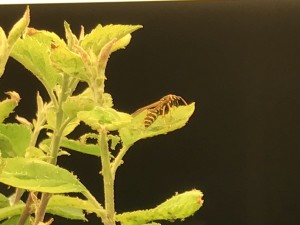
Before you go and grab a can of insecticide to kill those pesky yellow jackets have you considered the fact that they eat aphids, flies, caterpillars and grasshoppers? In many ways they are beneficial. Their omnivorous nature lends itself well to eating the soft bodied structure of the dreaded aphid for example. They also help to sanitize outdoor animal processing stations, eat rotting fruit and they help take care of carrion in general. Yellow jackets are amazing beneficial insects if you can stand them!
Yellowjacket Life Cycle
Yellow jackets are a type of social wasp that lives in colonies. fertilized queens are the only ones that will overwinter and in late spring they emerge from hibernation and feed and build nests in order to lay their eggs. Most of the time, but not always, yellowjackets look for ground based nesting sites using plant fibers, woody or pulp like material. The queen lays eggs, the workers are born, in turn, they protect the queen and nest, they collect and bring back food for their up and coming larvae mates. The colony grows and by fall a new crop of queens and workers are born, the old breed dies and the cycle repeats.
Beneficial or Harmful?
There is no doubt that many variables must be considered that determine the difference between living in harmony with yellow jackets and wanting them to all die a quick death! If someone in the family is highly allergic to the venom and would likely endure anaphalactic shock then the answer is pretty clear. You’re probably going to get rid of them to the maximum extent possible. If you have honey bees and the yellow jackets are terrorizing and destroying hives then it’s understandable to significantly reduce their numbers. It’s a delicate balance between being a beneficial insect and the desire not to have them around. Keep in mind that pest management is a more realistic goal than pest control. In other words, if you don’t want yellow jackets around then reducing their numbers is a more realistic goal instead of “eradication.”
Create a Naturally Balanced System
On our homestead we live with yellow jackets, paper wasps and many other “pests.” Our basic strategy is to try and create a naturally balanced system where the table has not been set for any single pest or disease. In this way we hope to achieve some kind of equilibrium between beneficial and harmful insects and we set a pretty high threshold for losses. We accept that we will lose a certain amount of plants each year. We also know that in some cases the pest pressure will get high before beneficial insects are attracted to the area. Again, we accept this in order to reduce inputs and mimic nature.
Helpful Partners at a Distance
We do not let any kind of wasp nests be built on our structures or in key, high traffic areas. In late spring we frequently inspect structures and knock down nests before they get a chance to build. We also stay on the lookout for ground nests that are in precarious areas and take care of them as soon as we find them. Other than that, we leave them alone. They are our helpful partners in controlling pests and helping to sanitize our animal processing areas. Due to the yellow jacket life cycle they are especially numerous in fall so watch out!
Yellowjacket Queen
Over winter we grow many types of plants indoor: trees, bushes, herbs and vegetables. This year we had a decidedly bad aphid problem in our grow room. As we considered our options of Neem oil, insecticidal soaps and other organic type remedies a curious thing happened. Out of no where, or out of hibernation to be precise a yellow jacket queen showed up eating aphids off of our plants. Where was she hibernating? We don’t know but it could have been an attic or vent area. We know that she likely was somewhere in our structure because we are still in deep winter here in North Idaho and the likelihood of her coming out of hibernation outside is very slim.
She Stays!
Our first instinct was that we DID NOT want a wasp in our home and how this would be a great opportunity to get rid of a queen and reduce (not eradicate) the wasp population this year. But, the more and more we watched her we realized that she is in a post-hibernation ravenous eating stage and we decided that she gets to stay! The tricky part about this is timing. We want her to continue to be an aphid eating machine but we don’t want her to make a nest, lay eggs and grow workers. We are watching her closely and when she is laying her eggs it will be time for her to go! We will toss her outside and she may or may not make it due to the timing of our seasons.
This is a very small example of looking at a yellow jacket in a different light.
Sean and Monica Mitzel are the proprieters of Huckleberry Mountain Homestead & Breakfast a Bed & Breakfast with a homestead twist. They homestead with their family on 40 acres and are using permaculture techniques and methods for the property. The homestead is a demonstration and education site where they teach workshops and raise dairy goats, sheep, pigs, rabbits, chickens, and ducks. The Mitzels have planted food forests, guilds and enjoy wildcrafting and propagating plants. Sean and Monica can often be found speaking and teaching at different events. To learn more about the Mitzels, visit The Prepared Homestead.
Check out our online community for great content!
Sean and Monica are available for consulting work regarding property analysis & design, and speaking engagements.




Leave a Reply
You must be logged in to post a comment.